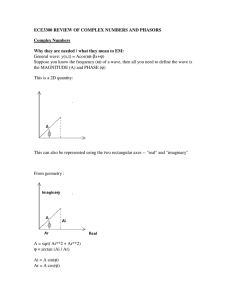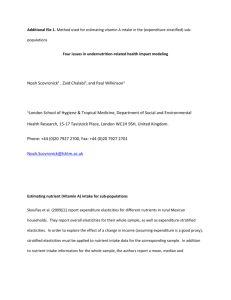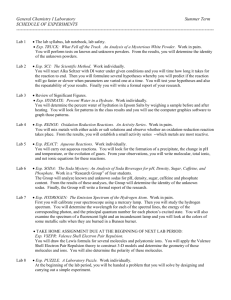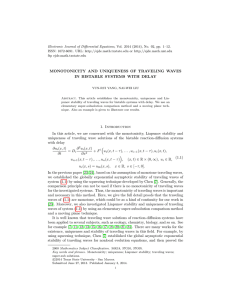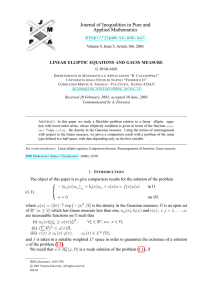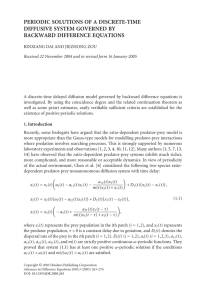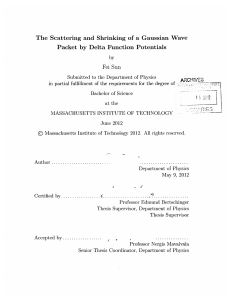Impedance Concepts and Thévenin Equivalent Systems
advertisement
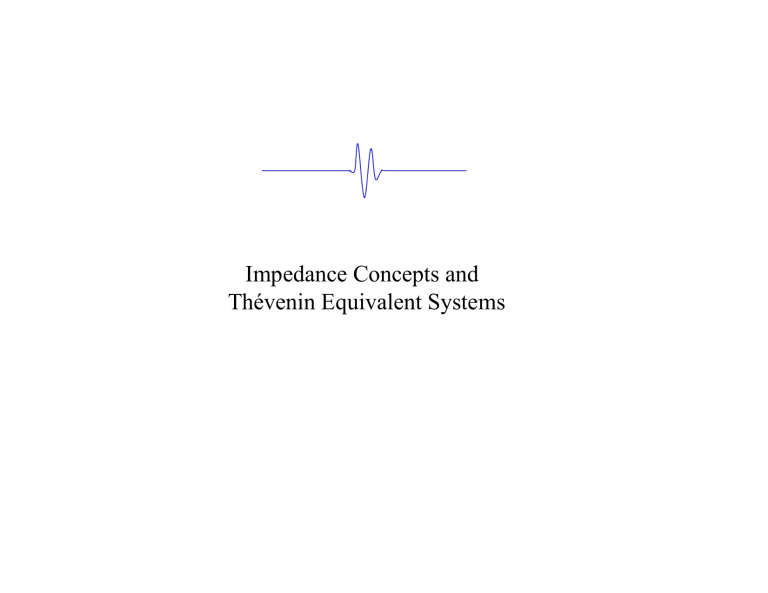
Impedance Concepts and Thévenin Equivalent Systems Learning Objectives Electrical impedance Description of 1-D waves in a fluid equation of motion/constitutive equation plane l waves - pulses l andd harmonic h i waves frequency and wavelength acoustic impedance Thévenin equivalent electrical circuits Concept of Impedance basic circuit elements V(t) I(t) resistor it V (t ) = R I (t ) capacitor dV (t ) C = I (t ) dt i d inductor dI ( t ) V (t ) = L dt For alternating (harmonic) voltages and currents I (t ) = I 0 exp ( −iω t ) resistor capacitor inductor general impedance V ( t ) = V0 exp ( −iω t ) V0 = R I 0 I0 V0 = −iω C V0 = −iω L I 0 V0 = Z (ω ) I 0 electrical impedance Z = Ze (ohms) 1-D plane wave traveling wave in a fluid p(x, t ) … pressure in the fluid ρ … fluid density vx (x, t) … velocity dy p dz dx ∂p p + dx ∂x ∑ F = ma ∂vx ∂p ⎞ ⎛ − ⎜ p + dx ⎟ dydz + pdydz = ρ dxdydz ∂x ⎠ ∂t ⎝ Equation of motion ∂vx ∂p − =ρ ∂x ∂t Constitutive equation ∂u x p = −K ∂x dux dx 1-D wave equation i K … compressibility ibili off the h fluid fl id ux … displacement ∂u x ΔV = = relative change in volume ∂x V ∂ 2 ( ∂u x / ∂x ) ∂2 p − 2 =ρ ∂x ∂t 2 ρ ∂2 p = K ∂t 2 ∂2 p 1 ∂2 p − 2 2 =0 2 ∂x c f ∂t cf = K ρ wave speed in the fl id fluid 1-D plane wave solutions p = f ( t − x / c f ) + g (t + x / c f ) f g x Harmonic waves (or Fourier transforms of transient waves) p = A ( f ) exp ⎡⎣ −2π if ( t − x / c f ) ⎤⎦ + B ( f ) exp ⎡⎣ −2π if ( t + x / c f ) ⎤⎦ Fourier transform pair +∞ V ( f ) = ∫ v(t ) exp(2πi f t )dt −∞ +∞ v(t ) = ∫ V ( f ) exp(−22πi f t )df −∞ Let then V ( f ) = V% ( f ) exp ⎡⎣ 2π if ( x / c f ) ⎤⎦ v (t ) = +∞ ∫ V% ( f ) exp ⎡⎣2π if ( x / c −∞ f − t ) ⎤⎦ df 1-D plane wave traveling in the +x-direction Thus v(t) is a superposition of plane waves Thus, Now, let u = (t − x / c f ) +∞ Then % ( f ) exp [ −2π ifu ] df = v% ( u ) = v% ( t − x / c V f ∫ ) −∞ where v% ( t ) ↔ V% ( f ) so v% ( t − x / c f ) = +∞ ∫ V% ( f ) expp ⎡⎣2π iff ( x / c −∞ f − t ) ⎦⎤ dff Thus, we can always synthesize a traveling plane wave pulse with i h a superposition i i off harmonic h i plane l waves. various forms of a harmonic plane wave traveling in the +x-direction p = A exp ( 2π ifx / c f − 2π ift ) = A exp ( 2π ifx / c f − iωt ) f = ω / 2π = A exp ( ikx − iωt ) k = ω / cf = A exp ( 2π ix i / λ − iωt ) λ = 2π / k = c f / f f ... frequency (cycles/sec) ω …frequency (rad/sec) k … wave number (rad/length) λ …wavelength wavelength (length/cycle) p = A exp ( 2π ifx / c f − 2π ift ) magnitude of the pressure at a fixed x versus time, t: t T… period (sec/cycle) 2π ifT = 2π i f = 1 T ω = 2π f rad/cycle f frequency ( l / ) (cycles/sec) circular frequency q y ((rad/sec)) p = A exp ( 2π ifx / c f − 2π ift ) magnitude i d off the h pressure at a fixed fi d time, i t, versus distance, di x: x λ ... wavelength (length/cycle) fx = 1 λ k = 2π f x = rad/cycle spatial frequency (cycles/length) 2π λ spatial circular frequency ( (wave number) b ) (rad/length) ( d/l h) p = A exp ( 2π ifx / c f − 2π ift ) magnitude of the pressure at a fixed time, t, versus distance, x: x λ ... wavelength (length/cycle) 2π i f λ / c f = 2π i f λ = cf fundamental relationship that shows how the f frequency off a plane l harmonic h i traveling li wave is i related to its wavelength Example: consider a 5MHz plane wave traveling in water ( c =1500m/sec). What is the wave length? 1.5 × 106 mm / sec λ= 5 × 106 cycle l / sec = 0.3mm / cycle F a plane For l pressure wave traveling li in i the h x-direction di i p = f (t − x / c f Let ) u = t − x / cf then ∂vx ∂p − =ρ ∂x ∂t ∂p df ( u ) ∂u 1 = =− f′ ∂x du ∂x cf ∂vx 1 = f′ ∂t ρc f 1 vx = ρc f ∫ 1 f ′∂t = ρc f df f p ∫ du du = ρ c f = ρ c f p = ρ c f vx za = ρc f S … area x specific acoustic impedance of a pplane wave (p (pressure/velocity) y) F = pS = ρ c f vx S F = Z a vx Z a = ρc f S acoustic impedance of a plane wave (force/velocity) F more generall (harmonic) For (h i ) waves F = Z a (ω ) v Thévenin equivalent circuit (harmonic voltages and currents) R1 Vi C1 R2 R3 V L1 I Vs(ω) ( ) Zeq(ω) I V Determining the Thévenin equivalent source Vs(ω) Zeq(ω) V0 open-circuit voltage Vs = V0 D t Determining i i the th Thévenin Thé i equivalent i l t impedance i d Vs − VL = Z eqe I VL = RL I Vs(ω) Zeq(ω) RL VL ⎛ Vs ⎞ Z eq = RL ⎜ − 1⎟ ⎝ VL ⎠ Example: find the Thévenin equivalent circuit for the following circuit R Vi C R Vi I V0 C open-circuit p voltage g Vi − V0 = IR V0 = I −iω C eliminatingg I,, we find Vi V0 = 1 − iω RC Thévenin equivalent source R Vi I1 Vi − VL = I1 R C RL I2 VL = I 2 RL VL VL I1 − I 2 ) ( = −iω C Vi eliminating I1 , I2 gives VL = (1 − iω RC ) + R / RL so ⎧⎪ (1 − iω RC ) + R / RL ⎫⎪ ⎛ V0 ⎞ Z eq = RL ⎜ − 1⎟ = RL ⎨ − 1⎬ (1 − iω RC ) ⎪⎩ ⎝ VL ⎠ ⎭⎪ ⎧⎪ R / RL ⎫⎪ R = RL ⎨ = ⎬ ⎪⎩ (1 − iω RC ) ⎪⎭ (1 − iω RC ) R Vi((ω)) Vi (ω ) VS (ω ) = 1 − iω RC C Z eq (ω ) = R 1 − iω RC In many EE books the equivalent impedance is obtained by simply shorting out (removing) the source and examining the ratio V/I at the output port: R I I1 V C V = R ( I − I1 ) I V= 1 −iωC V = R ( I + iωCV ) V (1 − iω RC ) = RI V R Z eq = = I 1 − iω RC
